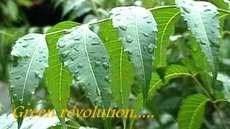Tamil: Seethaphalam
English : Custard Apple
botanical name : 'ANNONA SQUAMOSA'.
Unrelated to the ubiquitous apple,
the sugar is a tree native to the tropics of South America and is now grown in
many regions around the world, from China
to Africa . The sugar apple, also known intensely in India
The
sugar apple grows in tropical and subtropical areas, but it flourishes in a
variety of soil types, and is moderately resistant to drought. This flexibility
has allowed it to grow on five continents.
The principle use of sugar apples is
raw consumption of the
fruit, which are segmented, knobby clusters of juicy, sweet flesh. In Malaysia
When eating a sugar apple, one must
mind the seeds, which are abundant, hard, and toxic if ingested. This toxicity , however, has shown promise as a
natural pesticide. Oil extracted from the seeds has been shown in studies to be as effective as conventional pesticides at
eliminating pests from crops such as tomatoes, melons, and soybeans in
greenhouse conditions. Furthermore, subsequent testing showed that the
compounds break down quickly, are no longer toxic after two days, and are
completely inactive after eight days. The same potency allows seed powder to be
used as a lice treatment.
Ironically, the sugar apple has
proven vulnerable to a variety of pests and blights, which has discouraged its
cultivation in the Caribbean and South America .
Indian growers have developed several techniques to counter these pests, which
may help reignite the sugar apple’s popularity in the Americas Florida
As
sugar apple cultivation expands, the trees could be grown alongside other
crops, providing natural pesticides and enriching local diets with more
variety. Sugar apples may prove to be more than just a casual tropical snack.
Custard apple benefits:
1.The seeds of the fruit have insecticidal
and abortifacient properties.
2. Custard apple serves as an expectorant,
stimulant, coolant and haematinic and is even useful in treating anemia.
3. Vitamin A present in the fruit is good
for hair, eyes and healthy skin.
4. The fruit, in its unripe form, can be
dried, crushed and used for treating diarrhea and dysentery.
5. The paste of the flesh of the fruit can
be used for local application on ulcers, abscesses and boils.
( Skin
infections such as abcessess or ulcers can be treated with custard apple. Simply
grind the flesh into a thick paste and
apply it to the affected area.)
6. As it contains low fat levels, it is
good for maintaining optimum health.
7. It is a rich source of dietary fiber,
which helps in digestion.
8. Copper is yet another useful ingredient
of custard apple.
(copper which helps the body to
form hemoglobin. This is especially useful for pregnant women as they need
about 1000 micrograms of copper daily. Eating custard apples during pregnancy
is therefore beneficial for the mother and child.)
9. Potassium and Vitamin B6 are also
present in custard apple.
10. Custard apple contains magnesium, which
plays vital role in relaxing muscles and protecting heart against diseases.
11. Custard apple is a storehouse of
Vitamin C, which is an anti oxidant and helps in neutralizing free radicals.
Custard apple recipes
Here is one of the many easy custard apple recipes.
Custard Apple cream
2 deseeded custard apples, pureed with a bit of lemon
500 g soft light cream cheese
3 tablespoons gelatin
1/3 cup boiling water
½ cup caster sugar
190 ml cream
500 g soft light cream cheese
3 tablespoons gelatin
1/3 cup boiling water
½ cup caster sugar
190 ml cream
Dissolve the gelatin into the 1/3 cup of boiling water. Beat the
softened cream thoroughly and then Pour into mould/glasses and set for about 8
hours.
Do you know of other local plants
that can be used to provide natural protection from pests? Tell us in the
comments!

